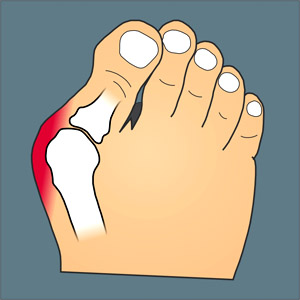Another of those "Well I never…" papers.
I don't have Hallux valgus, but I do have somewhat unusual feet.
Many of us have little things that we do like snap our fingers. Or interlace the fingers of our hands. In some, these are very obvious traits.
Something has always compelled me to move my hallux (big toe) over the next toe - a bit like in the picture. Differences being lack of problem with the joint, and that the hallux wants to go above the next toe rather than push it out of the way. And I then snap my big toe down.  (I simply can't wear a pair of shoes that prevent me from doing that! Just have to take them off immediately.)
(I simply can't wear a pair of shoes that prevent me from doing that! Just have to take them off immediately.)
Foot Ankle Surg. 2019 May 30. pii: S1268-7731(19)30076-1. doi: 10.1016/j.fas.2019.05.014. [Epub ahead of print]
Incidence of thyroid disease in patients with forefoot deformity.
Tran SK1, Carr JB1, Hall MJ1, Park JS1, Cooper MT2.
Author information
1 University of Virginia School of Medicine, Charlottesville, VA, USA.
2 University of Virginia School of Medicine, Charlottesville, VA, USA. Electronic address: mtc2d@virginia.edu.
Abstract
BACKGROUND:
Hallux valgus and lesser toe deformities are common foot disorders with substantial functional consequences. While the exact etiologies are multi-factorial, it is unknown if certain endocrine abnormalities, such as thyroid dysfunction, may be associated with these pathologies. The current study sought to investigate the prevalence of thyroid disease in patients with hallux valgus or lesser toe deformities.
METHODS:
Every new patient who presented to our institution's foot and ankle clinic during a three-month time period was given a survey to determine the presence of a known thyroid disorder. The diagnosis for each visit was then recorded. Additionally, a national, publicly available database was queried for patients diagnosed with thyroid disease and concomitant hallux valgus or specific forefoot pathology. Odds ratios for the presence of thyroid dysfunction were then calculated for each patient group.
RESULTS:
Three-hundred and fifty initial visit patient surveys were collected, and 74 (21.1%) patients had a known diagnosis of thyroid disease. The most common diagnoses were primary hypothyroidism (n = 61, 17.4%), secondary hypothyroidism (n = 6, 1.7%), thyroiditis (n = 4, 1.1%), and hyperthyroidism (n = 3, 0.9%). Thyroid disease was present in 16 of 26 patients (61.5%) with a diagnosis of hallux valgus (OR 7.3, CI[3.16-16.99], p<0.0001). Lesser toe deformities, including hammertoes, mallet toes, bunionettes and crossover toes, were also significantly associated with thyroid disease (OR 5.45, CI[1.83-16.26], p<0.002). The national database revealed 905,924 patients with a diagnosis of a specific forefoot deformity, and 321,656 of these patients (35.5%) had a concomitant diagnosis of a thyroid condition (OR 2.11, CI[2.10-2.12], p<0.0001).
CONCLUSIONS:
The current study suggests a significant association between forefoot pathology and thyroid dysfunction, especially hallux valgus and lesser toe deformities. Increased understanding of these correlations may offer an important opportunity in population health management, both in diagnosis and treatment. While further studies with long-term outcomes are necessary, the early diagnosis of thyroid disease may provide an opportunity to predict and potentially alter the course of forefoot pathology.
Copyright © 2019 European Foot and Ankle Society. Published by Elsevier Ltd. All rights reserved.
KEYWORDS:
Forefoot pathology; Hallux valgus; Hyperthyroidism; Hypothyroidism; Lesser toe deformity; Thyroid disease
PMID: 31186135
DOI: 10.1016/j.fas.2019.05.014
ncbi.nlm.nih.gov/pubmed/311...
Image: By Malmstajn - Own work, CC BY 3.0, commons.wikimedia.org/w/ind...





